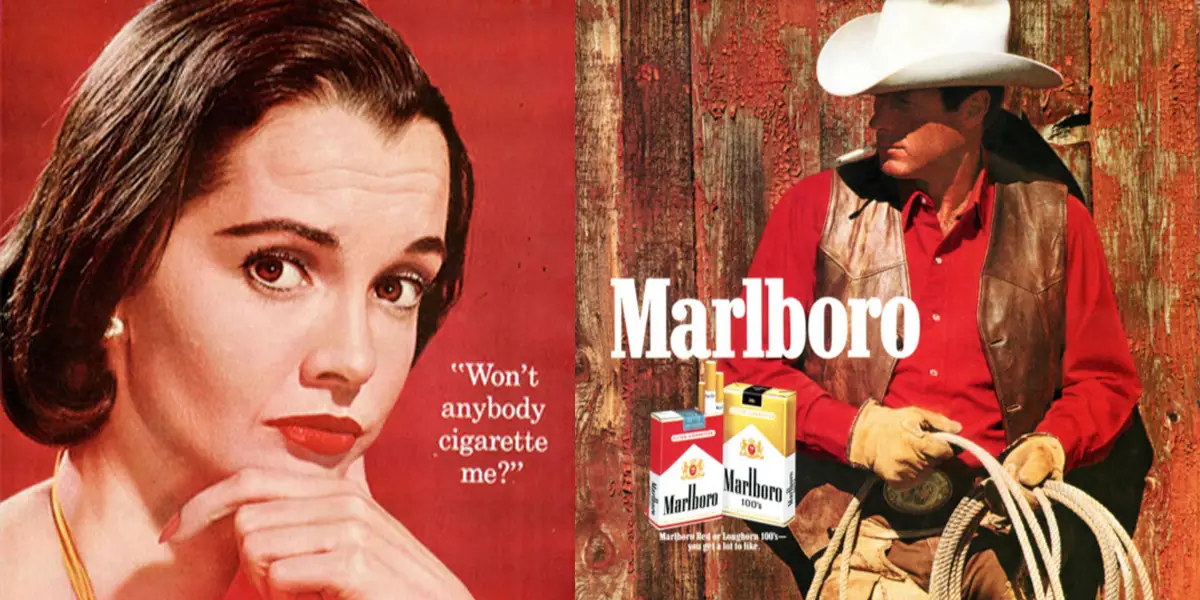Marlboro: Same Product, Different Audience = Success

A huge accomplishment was the transformation of Marlboro from a cigarette for women to the symbol of a manly smoking culture.
Marlboro’s transformation from a brand aimed at women to the archetypal “man’s cigarette” is a prime illustration of effective brand repositioning. The strategy and backstory behind Marlboro’s unexpected shift in target demographic can be found below:

Original Positioning: A Women’s Cigarette
Philip Morris first introduced the Marlboro brand of premium cigarettes to women in the 1920s. Early advertising for the brand used the phrase “Mild as May,” which portrayed the product in a positive light, appealing to female smokers because of its perceived mildness.
- Design of the Product
The crimson-red filter on Marlboro cigarettes served as a functional design decision to conceal lipstick stains, a prevalent problem among female smokers in that era. Reinforcing the brand’s appeal to women, the packaging and marketing used feminine colours and images.
Challenges Experienced
- A Lessening of Interest
Even though Marlboro was successful at first, sales began to decline in the 1950s. As male smoking habits remained dominant in the market, the brand’s link with femininity further diminished its attractiveness. Brands in the tobacco business have to rethink their positioning tactics in light of growing public concern about health.
The Rugged Male: A New Target for Repositioning
- A Change to the Storyline
Philip Morris rebranded Marlboro as a men’s cigarette in the early 1950s, in response to growing public awareness of smoking’s health risks, particularly those associated with smoking unfiltered cigarettes. Making an image that screamed toughness, manliness, and power was the plan.
- The Marlboro Man
This repositioning was fueled by the 1954 invention of the now-iconic “Marlboro Man.” Traditionally, people have portrayed the Marlboro Man as a strong, independent, and untamed cowboy. The outdoor, free, and wild lifestyle that this cowboy picture portrayed resonated with male customers.
- Advertising Strategy
Advertisements showcasing the Marlboro Man appeared in print and on television as part of Philip Morris’s aggressive promotional push. The advertisements often featured wide-open vistas, further associating the brand with independence and nature. The association of the gruff cowboy with Marlboro completely transformed the brand’s image.
To read more – https://onlykutts.com/index.php/2021/09/02/marlboro-come-to-where-the-flavour-is/

- Product Design and Packaging
The packaging was redesigned, and the advertising campaign was updated. The cigarette pack prominently features the brand’s emblem, symbolizing power and excellence, with a colour scheme of red, white, and gold, giving it a stronger, more manly appearance. Although it was initially intended for ladies, the red filter was kept and given a new meaning as a sign of roughness.
Impact and Strategy
- Highlighting Masculinity
Marlboro’s repositioning approach relied heavily on the concept of masculinity. Philip Morris successfully changed the brand’s image from soft and feminine to strong and masculine by linking it with the Marlboro Man.
- Psychological Appeal
During the post-war period, the repositioning tapped into psychological factors that resonated with men. Being strong, capable, and autonomous, the cowboy embodied the ideal male character. The idealised portrayal of masculinity and the pursuit of these traits were attractive to the men associated with them.
- Targeting a Broader Audience
Thanks to the repositioning, Marlboro was able to reach more people. By the 1970s, Marlboro had outperformed all other cigarette brands in terms of market share, solidifying its position as the world’s top-selling brand. With the help of the Marlboro Man, the tobacco company solidified its position in popular culture and advertising history.
Outcome
A huge accomplishment was the transformation of Marlboro from a cigarette for women to the symbol of a manly smoking culture. It prevented the brand’s sales from falling further and turned it into a worldwide phenomenon. Marlboro’s technique demonstrated the potential of a compelling storyline, striking visuals, and targeted advertising to radically alter brand perception and attract a wider demographic. Because of the Marlboro Man’s lasting impact, Marlboro is still one of the most popular and profitable cigarette brands in the world.




1 Comment